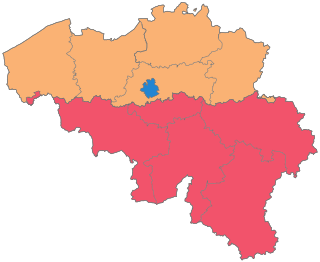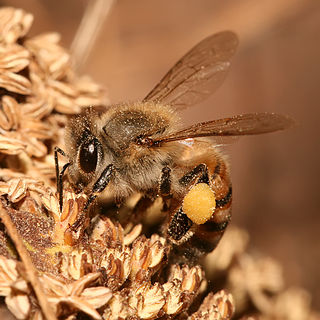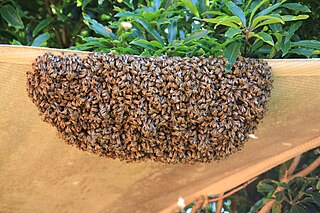
Honey is a sweet and viscous substance made by several bees, the best-known of which are honey bees. Honey is made and stored to nourish bee colonies. Bees produce honey by gathering and then refining the sugary secretions of plants or the secretions of other insects, like the honeydew of aphids. This refinement takes place both within individual bees, through regurgitation and enzymatic activity, and during storage in the hive, through water evaporation that concentrates the honey's sugars until it is thick and viscous.

Mead, also called hydromel, is an alcoholic beverage made by fermenting honey mixed with water, and sometimes with added ingredients such as fruits, spices, grains, or hops. The alcoholic content ranges from about 3.5% ABV to more than 20%. The defining characteristic of mead is that the majority of the beverage's fermentable sugar is derived from honey. It may be still, carbonated, or naturally sparkling; dry, semi-sweet, or sweet.

A honeycomb is a mass of hexagonal prismatic cells built from wax by honey bees in their nests to contain their brood and stores of honey and pollen.

The Kingdom of Belgium is divided into three regions. Two of these regions, Flanders and Wallonia, are each subdivided into five provinces. The third region, Brussels, does not belong to any province and nor is it subdivided into provinces. Instead, it has amalgamated both regional and provincial functions into a single "Capital Region" administration.

The Africanized bee, also known as the Africanized honey bee and colloquially as the "killer bee", is a hybrid of the western honey bee, produced originally by crossbreeding of the East African lowland honey bee (A. m. scutellata) with various European honey bee subspecies such as the Italian honey bee (A. m. ligustica) and the Iberian honey bee (A. m. iberiensis).
Grayanotoxins are a group of closely related neurotoxins named after Leucothoe grayana, a plant native to Japan originally named for 19th century American botanist Asa Gray. Grayanotoxin I is also known as andromedotoxin, acetylandromedol, rhodotoxin and asebotoxin. Grayanotoxins are produced by Rhododendron species and other plants in the family Ericaceae. Honey made from the nectar and so containing pollen of these plants also contains grayanotoxins and is commonly referred to as mad honey. Consumption of the plant or any of its secondary products, including mad honey, can cause a rare poisonous reaction called grayanotoxin poisoning, mad honey disease, honey intoxication, or rhododendron poisoning. It is most frequently produced and consumed in regions of Nepal and Turkey as a recreational drug and traditional medicine.

Beekeeping is the maintenance of bee colonies, commonly in man-made beehives. Honey bees in the genus Apis are the most commonly kept species but other honey producing bees such as Melipona stingless bees are also kept. Beekeepers keep bees to collect honey and other products of the hive: beeswax, propolis, bee pollen, and royal jelly. Other sources of beekeeping income include pollination of crops, raising queens, and production of package bees for sale. Bee hives are kept in an apiary or "bee yard".

A worker bee is any female (eusocial) bee that lacks the full reproductive capacity of the colony's queen bee; under most circumstances, this is correlated to an increase in certain non-reproductive activities relative to a queen. While worker bees occur in all eusocial bee species, the term is rarely used for any bees other than honey bees.

For bees, their forage or food supply consists of nectar and pollen from blooming plants within flight range. The forage sources for honey bees are an important consideration for beekeepers. In order to determine where to locate hives for maximum honey production and brood one must consider the off-season. If there are no honey flows the bees may have to be fed. Bees that are used for commercial pollination are usually fed in the holding yards. Forage is also significant for pollination management with other bee species. Nectar contains sugars that are the primary source of energy for the bees' wing muscles and for heat for honey bee colonies for winter. Pollen provides the protein and trace minerals that are mostly fed to the brood in order to replace bees lost in the normal course of life cycle and colony activity.
Elections in Luxembourg are held to determine the political composition of the representative institutions of the Grand Duchy of Luxembourg. Luxembourg is a liberal representative democracy, with universal suffrage guaranteed under its constitution. Elections are held regularly, and are considered to be fair and free.

Swarming is a honey bee colony's natural means of reproduction. In the process of swarming, a single colony splits into two or more distinct colonies.
HoneyMonkey, short for Strider HoneyMonkey Exploit Detection System, is a Microsoft Research honeypot. The implementation uses a network of computers to crawl the World Wide Web searching for websites that use browser exploits to install malware on the HoneyMonkey computer. A snapshot of the memory, executables and registry of the honeypot computer is recorded before crawling a site. After visiting the site, the state of memory, executables, and registry is recorded and compared to the previous snapshot. The changes are analyzed to determine if the visited site installed any malware onto the client honeypot computer.

Balisto is a wholemeal biscuit bar snack manufactured by Mars, Incorporated, consisting of a digestive biscuit centre and a variety of milky cream toppings, and coated in milk chocolate.
Abbamele is a honey-based product from the rural culture of Sardinia (Italy). The proper Sardinian name is also not rarely italianized into sapa di miele.

Honey extraction is the central process in beekeeping of removing honey from honeycomb so that it is isolated in a pure liquid form.

A besloten vennootschap or société à responsabilité limitée (SRL) is the Dutch and Belgian version of a private limited liability company. The company is owned by shareholders; the company's shares are privately registered and not freely transferable. It is the most common form of limited company in the Netherlands and Belgium.

A Luxembourg passport is an international travel document issued to nationals of the Grand Duchy of Luxembourg, and may also serve as proof of Luxembourgish citizenship. Besides enabling the bearer to travel internationally and serving as indication of Luxembourgish citizenship, the passport facilitates the process of securing assistance from Luxembourg consular officials abroad or other European Union member states in case a Luxembourg consular is absent, if needed.
Honey comes in various types based on the region it is grown and the types of flower that provide the nectar.
The accounting profession in Luxembourg is structured around Ordre des Experts-Comptables (OEC) which serves as the main accounting body in the country. Luxembourg accounting standards are inspired from neighbouring France and Belgium. Similar to France, Luxembourg has set up a Commissions des Normes Comptables (CNC) which serves as an advisor to the Ministry for Justice in respect of accounting related matters, e.g. waivers for presenting consolidated accounts.

Amygdalota are a type of almond cookie associated with the Cyclades. Although these cookies don't contain any coconut, they are sometimes called "Greek macaroons". They may be called rozethes, ergolavoi or troufes in some regions, and can be shaped like pears, or balls or other shapes. Whatever the shape, these cookies are usually made to be small enough to eat in one bite. They can be sweetened with honey and flavored with orange flower water or rose water. There are similar almond cookies found throughout the cuisines of the eastern Mediterranean region.













